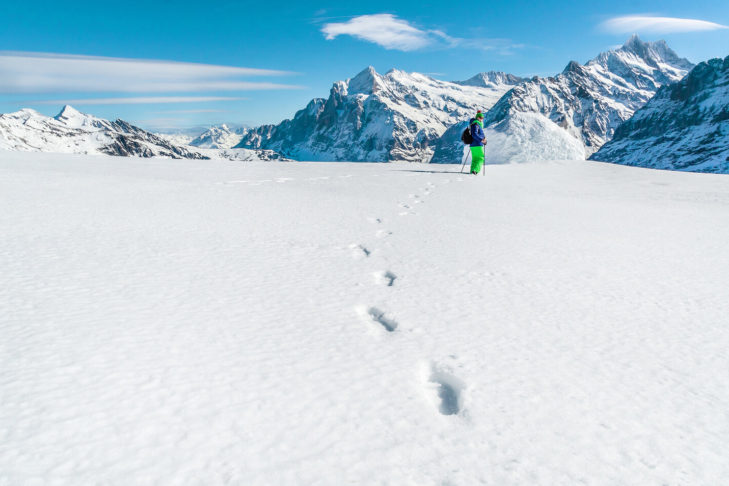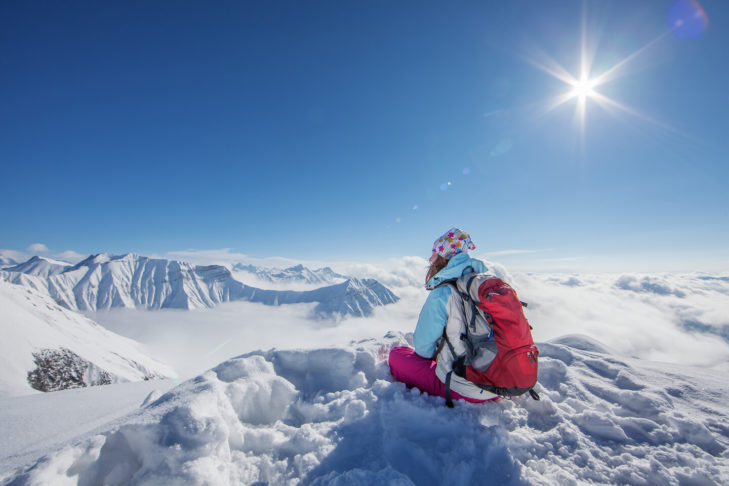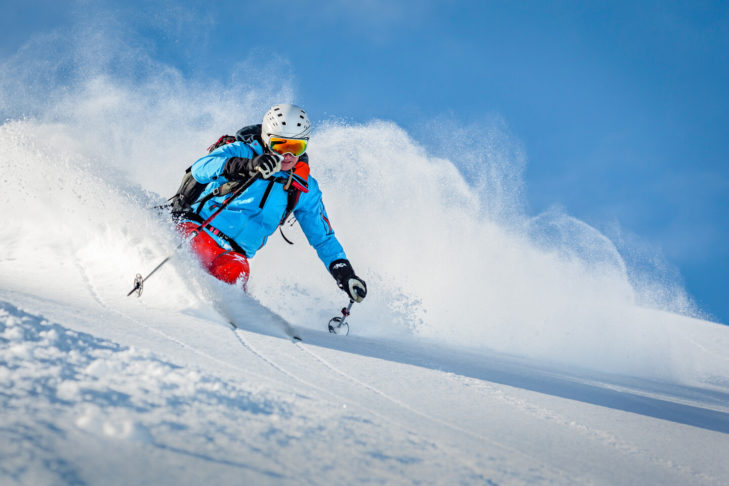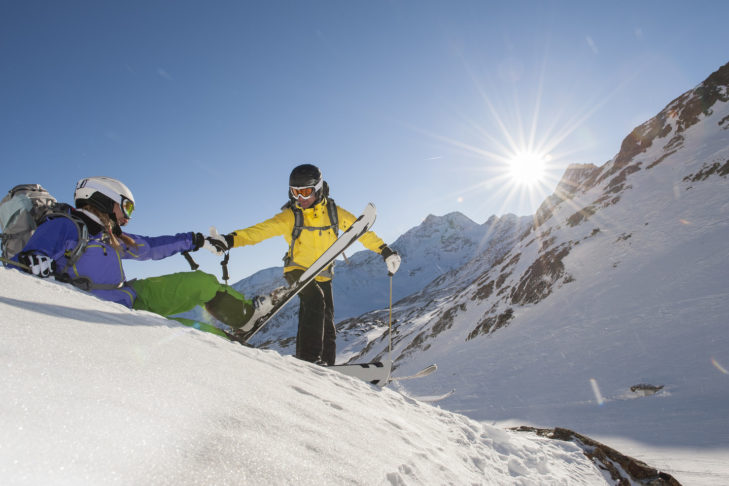Georg Leithner has been a mountain guide for 15 years and has spent his life in the mountains since childhood – in summer and winter. Leithner has been in charge of the SnowTrex Partner Skitourenwinter ski touring camps as a mountain guide since the beginning. in 2019, the full-time mountain guide from Pinzgau led the SnowTrex ski touring camp together with his mountain guide colleague and long-time friend Moritz Rabel and inspired the participants with his expertise and impressive stories from his expeditions. SnowTrex asked the 45-year-old about his profession and the fascination of mountaineering and ski touring and also summarised the most important information about the profession of “mountain guide”.
Interview with mountain guide Georg Leithner
Mr Leithner, what was your personal path to becoming a mountain guide?
I have always been in the mountains. From an early age, I climbed the high mountains of Austria with my father. One day I started climbing and travelled even more in the mountains. I finally joined the mountain rescue service in 1998 and worked there for several years. There I was then asked: “When are you actually going to do your mountain guide training? You spend so much time in the mountains and know your way around everywhere, surely that would be something for you?” I took this to heart and read up on the requirements for the aptitude test. Previously, I always thought that you had to be an exceptional mountaineer for this and I considered myself to be more of an average mountaineer. I then spent five years meticulously preparing for the training, all while working 100 per cent full-time and working shifts as a fitter in a mining company.
What qualifications do you need to work as a mountain guide?
As a mountain guide, you have to be able to demonstrate a very high level in all facets of mountain sports. For the entrance examination for training, a certain level is specified in all areas, which you have to master. For example, you must be able to free climb in the upper 7th degree in alpine climbing, have ski touring experience in normal grass mountains and on glaciers, ice and rock climbing, combined up to the 5th and 6th degree of difficulty. For the entrance exam, you also have to be able to ski at national ski instructor level, which is where most people fail.
Is your job the perfect combination of passion and profession?
If your passion for mountaineering is also your vocation, then being a mountain guide is of course a good thing! However, many people train as mountain guides for a different reason: it is the highest level of training you can get in mountain sports. That’s why many mountaineers use the training to put the finishing touches to becoming the perfect alpinist. Because they no longer get this from the Alpine Club. The profession, on the other hand, doesn’t interest them at all. Some also complete the training in order to finance their studies in the summer with guided tours. It can be said that out of 20 to 25 fully trained mountain guides, around five are left who actually practise the profession.
They are probably travelling extremely frequently as mountain guides and spend little time at home .. That comes with the job. But as you get older and have a relationship or a family, you try to bring your field of work closer to home. Unattached, without a house or family, it doesn’t matter whether you are travelling for weeks at a time, going to South America in the off-season or leading trekking tours in Nepal. However, once you have achieved a certain status in life, you naturally want to be at home more. Nevertheless, I have to have a few outliers, I can’t be in one place 365 days a year!
I now spend the winter at home. I know every slope here and get to know the weather and snow conditions throughout the season. That makes it much easier to assess the snow conditions. In other places, I have to prepare for a long time, enquire about the snow and work out the potential dangers first. That’s much more challenging than at home.
Winter or summer? Which is your favourite?
In both seasons, you experience all facets of mountain sports and the organisation of tours and route finding are identical. In summer, however, there are more challenging passages in terms of climbing technique. For me, summer is the easier season to practise the profession because there is no potential danger from avalanches. Nevertheless, winter is also cool! The ski touring camps in particular are great fun. In winter, it should ideally be a good mix of alpine training, ski touring and freeriding.
What makes ski touring so fascinating for you?
Being outdoors – with nature. Submitting to the forces of nature, i.e. avalanches. I myself, alone, am able to make decisions that can make the difference between life and death. I’m also impressed by these fascinating landscapes that the snow produces in combination with light, which we don’t have in summer. In winter, the diffuse incidence of light creates completely different contours, a completely different landscape. You can recharge your batteries in nature in the cosy, adventure-oriented way of ski touring and enjoy the tranquillity of nature and winter.
Can anyone go ski touring? What are the requirements for a (guided) ski tour?
Basically, anyone who can ski and has a certain level of physical fitness can go ski touring. The crux of the matter – where the joy often turns into suffering – is skiing ability. Often you’re still going uphill, but you’re already tired. If your skiing ability is then only mediocre or poor, it is no longer fun and it is also dangerous, as the risk of injury increases. The basic requirement is therefore a solid short turn so that you can master the snow conditions of varying difficulty. Many people say that they only go ski touring because of the ascent, but I also love going back down!
What tips would you give ski tour beginners?
I recommend basic training close to the piste for the ascent, where you can familiarise yourself with the equipment and practise your movements. Subsequently, you should work on improving your skiing level, also close to the piste. One day the time will come when you want to go off-piste. Then you have to decide: Where do I do what with whom? A camp like the one we have just organised with SnowTrex is a real opportunity to get to know what is relevant to ski touring apart from the equipment: weather, snow, avalanche awareness, group dynamics. You get to know all of this perfectly in such camps!
I therefore recommend that everyone attends a camp like this to get some basic input and not just follow someone blindly. If I’m going to follow someone, I can at least critically scrutinise afterwards whether everything they’re doing is right.
When can you venture into the terrain on your own?
However, I reckon you need at least five to ten years of regular ski touring with experienced people to be able to work out ski tours on your own in an area you’ve been to a few times. I don’t think it makes sense to simply travel to another location and go on a ski tour, as it is a challenge for us mountain guides to organise the tour safely. Especially if I don’t even know the area from summer.
Apart from that, it depends on how quickly and intuitively you can pick up and realise all the relevant factors and whether you’re more of an anxious type or a daredevil. If you stick to the elementary rules, you can also undertake easy ski tours that are not too far away from the secured area quite early on. Wild tours, on the other hand, require a great deal of experience. Map knowledge, equipment procurement, avalanche reports – there are many factors involved in the planning, so you have to be very sure of yourself. Or you can push your limits and increase your risk level. As an athlete, it’s up to you.
Do you consider ski touring a dangerous sport?
As dangerous as the individual ski tourer pushes the risk upwards. You can be very, very safe in this sport. With elementary reduction methods such as Werner Munter’s, you are travelling at a high level of safety, down to a few percent of the unavoidable. With such strategies, which define a socially accepted residual risk, you can go skiing safely. If something does happen, it’s just bad luck.
The problem, however, is that there is no obligation to use these methods. In retrospect, it is often impossible to determine whether an accident happened because of the residual risk or whether it was really reckless.
What role does the media play?
It’s always hyped up in the media when something happens because it’s a fringe sport. It’s not like driving a car, because driving a car is generally accepted. Everyone knows the risk and accepts it. Road traffic is very dangerous and although everyone has to have a driving licence, accidents do happen. A legal framework has been created, but people still make mistakes and accidents happen. It’s no different out in the mountains. Many people know their way around and are considerate, and yet sometimes something happens because you may have misjudged something.
Despite the increasing number of ski tourers – now over 500,000 – the number of accidents remains constant at around 20 to 30 avalanche fatalities per winter in Austria. This means that ski touring is becoming ever safer.
What appeals to you most about your job and about mountaineering?
The best thing about mountaineering is that you are reduced to yourself out in nature. The mountain is not a piece of sports equipment. It doesn’t matter what equipment you have or that you are technically adept: if the weather doesn’t play ball, you can humbly turn back without having achieved anything.
When you are in the middle of the mountains like in Nepal and there are no people to be seen for a hundred kilometres, you think to yourself: Who needs people? Nature is so wonderful – even without people. Experiencing this is simply sensational about mountaineering. Apart from that, mountaineering is a school of life, you make friends for life and have fun together. That’s brilliant!
A great contrast to the loneliness in the mountains …
Exactly, on the one hand this “nothing” and on the other hand a company that is like-minded and also loves the fact that there is nothing up there. Showing these like-minded people as a mountain guide that you can move safely in the mountains and enjoy them is always an experience! And a self-affirmation when you arrive back in the valley in good health after a successful tour, drink a beer together and finally say goodbye as good friends.
After numerous expeditions in the past, what are your new projects?
The next project is a sailing licence! After 45 years in the mountains, I would now like to see the sea.
General information on the topic “Mountain guide”
Climbing untouched slopes on touring skis, marvelling at unique mountain panoramas and enjoying the mountain landscape. Most snow and nature lovers set off into the mountains on their own, hoping for promising landscape panoramas, unique nature experiences and, if possible, a descent through untouched powder. However, most ski tourers do not realise the importance of a mountain guide or the advantages of a guided ski tour. Thanks to the experience of the professionals, their in-depth local knowledge and special training, guided mountain tours not only promise safety and orientation, they also take nature lovers to unique viewpoints, hidden places and fabulous, avalanche-safe deep snow slopes. So the option of a mountain guide should definitely be considered for your next ski tour.
Training as a mountain guide
Training to become a state-certified mountain and ski guide consists of a combination of theory and practice, as with most courses. For admission to the demanding training programme, all-round skills on rock, ice and skis must be demonstrated in three aptitude tests. Only after passing the exams are the so-called aspirants allowed to start the actual training programme.
The three-year training programme consists of theoretical and practical modules. It can either build on each other or be organised according to individual planning. In addition to the “Technique of guiding in any alpine terrain” and the “Didactics and methodology of knowledge transfer”, aspirants are also taught comprehensive theoretical knowledge. A large part of the content covers the topics of rock, ice and winter. In addition, an internship of at least 36 days is required during the course of the training programme. This must be completed at a mountain and ski school. Here, aspirants gain practical experience and benefit from the knowledge of experienced mountain and ski guides. Each study block concludes with an examination on guiding techniques, teaching activities and personal skills. If an aspirant passes all the course examinations, the prospective specialist athlete is authorised to take the state examination to become a mountain and ski guide. Within two days, the authorised aspirant must demonstrate their specialist knowledge in theory during this examination.
After completing the final examination, the newly qualified mountain and ski guide has all the skills to guarantee prospective customers the fulfilment of well-being, enjoyment and safety on guided hiking or ski tours. In addition, the “UIMLA International Mountain Leader” or “IVBV Mountain Guide” certificates are awarded, which according to the VDBS (Verband Deutscher Berg- und Skiführer e. V.) are solely recognised for commercial guiding in the mountains.
Reasons for a tour with a mountain guide
Many snow and nature lovers are unsure whether their tour should be accompanied by a mountain guide and whether this is worthwhile. Of course, it is cheaper to try your hand at the ascent alone, but one thing is certain: a mountain guide who leads the group safely through the winter wonderland brings experience and knowledge that will take the upcoming ski tour to a new level.
The saying “You never stop learning” sums up perfectly what makes the company of a mountain guide so valuable, because ski and mountain guides allow snow lovers to enter new terrain on ski tours that they would probably have avoided on their own. Conquering the route thus becomes a challenging and unique experience. Trained experts know numerous alternative routes, shortcuts and climbs that would be impossible to find on your own. Mountain guides also lead the group to fabulous powder descents. After a strenuous ascent, the descent on light powder snow is a reward in itself.
Fancy a tour with a mountain guide? SnowTrex has summarised all the important information about ski touring here for snow lovers who would like to read up on the subject of ski touring in advance.
FAQ about mountain guides
How much does a mountain guide earn?
The daily rate for mountain guides varies depending on the region and country. On average, however, the fee is around 500 euros.
What are mountain guides called?
Mountain guides are called alpinists. When training to become a mountain guide, however, they are called aspirants.
How many mountain guides are there in Austria?
There are a total of around 1,500 mountain guides and 30 female mountain guides in Austria.
How much does it cost to train as a mountain guide?
The cost of training depends on the country. In Germany, you can expect to pay between 10,000 and 15,000 euros.
What is a mountain guide needed for?
In addition to providing professional guidance that offers customers both safety and orientation, the mountain guide also takes on the careful planning of the tour, knows numerous alternative routes and shortcuts and gives simple tips and tricks on the right technique.
How long does it take to train as a mountain guide?
On average, training to become a mountain guide takes three years. However, the duration of training can vary due to the possibility of individual planning and the need for practical training.
What certificates do mountain guides receive after completing their training?
The “UIMLA International Mountain Leader” or “IVBV Mountain Guide” certificates are awarded upon completion of the training programme. According to the VDBS (Verband Deutscher Berg- und Skiführer e. V.), these are the only certificates recognised for commercial guiding in the mountains.
What does the price of a mountain guide depend on?
The cost of a mountain tour varies depending on the number of people, region, duration and difficulty of the tour.
What does the mountain guide training programme include?
Training to become a mountain guide consists of theoretical and practical specialisations. In addition to the “Technique of guiding in any alpine terrain” and the “Didactics and methodology of knowledge transfer”, aspirants also acquire a comprehensive understanding of the theoretical background.







